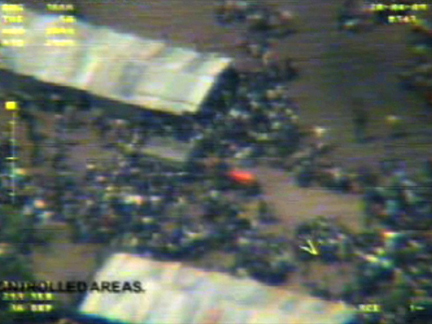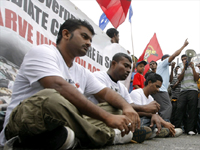Sri Lanka - our correspondent reports
35,000 civilians leave Tamil Tiger-controlled area, says President Rajapaksa
Article published on the 2009-04-20 Latest update 2009-04-20 13:12 TU

An image from the Sri Lankan military of people fleeing an area controlled by Tamil Tiger rebels on 20 April 2009
(Photo: Reuters)
Sri Lankan President Mahinda Rajapaksa has said that around 35,000 civilians have left the last area in the north of the country controlled by the Liberation Tigers of Tamil Eelam (LTTE).
Rajapaksa showed an aerial video from a spy plane which he said confirms the evacuation of civilians.
“The footage clearly shows that the people are defying the rebels and escaping. They are running to safety,” Rajapaksa said.
"From earlier on today, lots of people have started to come onto the government side, this followed a military operation, where security forces had captured part of the rebel defences," says correspondent Amal Jayasinghe. "It looked like the military were able to puncture part of the rebels’ defensive line, and that was a stretch of about three kilometres, and people started pouring out of that area."
Q+A Correspondent Amal Jayasinghe, Colombo
"From the images, it’s clear that people grabbed whatever they could, and they were running in droves, I’ve seen some of these images and you could make out people in very large numbers, some wading through a lagoon, to cross the lines and get over to the military side, so it looked like people were quite desperate to leave," Jayasinghe told RFI.
The LTTE have been accused of using civilians in the area as human shields, although the rebels have also blamed attacks on non-military facilities on government forces.
"The military did say that the Tamil Tigers tried to attack the civilians who were leaving, in some sort of attempt to discourage them from going across," said Jayasinghe.
“The process of the complete defeat of the LTTE has just begun,” the President told the AFP news agency.
"He appears certain now, that the Tamil Tigers have almost been completely defeated, so his message was that he wants the Tigers to surrender," said Jayasinghe, speaking from Colombo. "He was saying he really wanted to capture [LTTE leader Velupillai] Prabhakaran alive, and he would have to account for his actions."
Seventeen civilians were killed on Monday according to the military, in a reported suicide bombing intending to stop their escape.
Sri Lanka's offensive against the LTTE has prompted a number of international protests.
Thousands of Tamils restarted their demonstration outside the Houses of Parliament in London on Monday. As part of ongoing protests they are calling for an immediate ceasefire.
Meanwhile, in Sri Lanka it is unclear what measures have been put in place to accommodate the displaced civilians.
"They have been saying that they are ready to receive up to 100,000 people, but certainly we did not see any signs of infrastructure to support that kind of exodus," Jayasinghe says.










